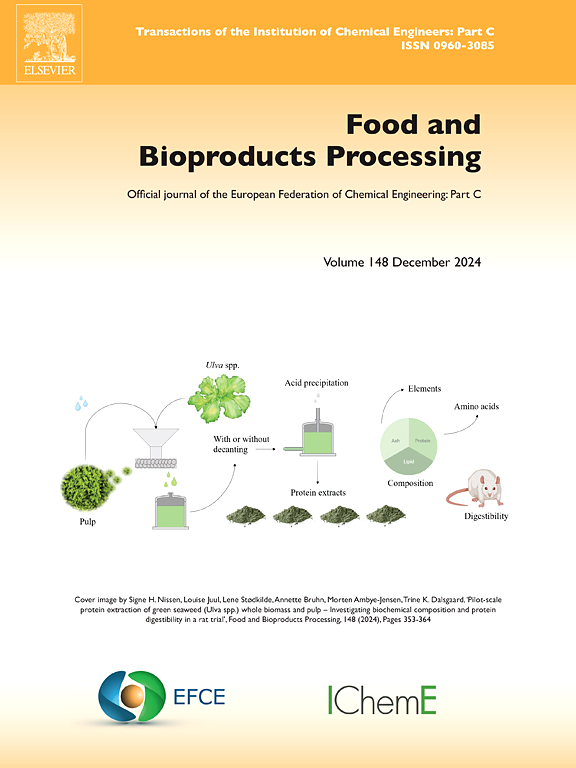提高 Cucumis momordica 种子的抗菌功效:纳米乳液在 Eurotium cristatum 介导的固态发酵中的应用
IF 3.5
2区 农林科学
Q2 BIOTECHNOLOGY & APPLIED MICROBIOLOGY
引用次数: 0
摘要
本研究通过Eurotium cristatum介导的固态发酵(SSF)及其在纳米乳液中的应用,重点探讨了通过固态发酵提高葫芦巴种子粉的特性,包括蛋白质含量、功能特性、稳定性和抗菌活性。发酵 144 小时后,蛋白质含量从对照组的 23.28±0.23% 显著增加到 29.83±0.12%。对发酵 96 小时的葫芦巴种子粉进一步分析了其功能特性和特征。吸水能力从 0.91 g/g 提高到 2.56 g/g,吸油能力从 0.79 g/g 提高到 1.16 g/g。扫描电镜和傅立叶变换红外光谱分析显示了形态变化和化学特征改变,表明酶降解和功能特性增强。发酵粉末制成的纳米乳液显示出更小的液滴尺寸(148±0.34 nm 到 126±0.37 nm)和更负的 zeta 电位(-24.5±0.12 mV 到 -25.79±0.18 mV),这表明其稳定性有所提高。发酵种子粉纳米乳液的温度稳定性更好,表明其耐热性更强。针对大肠杆菌和金黄色葡萄球菌的抗菌测试表明,发酵种子粉纳米乳剂的 MIC 值和 MBC 值明显降低(大肠杆菌 MIC:1.089 mg/mL,MBC:2.189 mg/mL;金黄色葡萄球菌 MIC:0.459 mg/mL,MBC:1.196 mg/mL),表明抗菌功效增强。这些结果凸显了 SSF 和纳米乳液技术在促进百日草籽作为天然抗菌剂的功能和应用方面的潜力。本文章由计算机程序翻译,如有差异,请以英文原文为准。
Advancing antimicrobial efficacy of Cucumis momordica seeds: Nanoemulsion application in Eurotium cristatum-mediated solid-state fermentation
This study explores the enhancement of Cucumis momordica seed powder's properties through Eurotium cristatum-mediated solid-state fermentation (SSF) and its application in nanoemulsions, emphasizing protein content, functional properties, stability, and antimicrobial activity. The protein content increased significantly from 23.28±0.23 % in the control to 29.83±0.12 % after 144 h of fermentation. The Cucumis momordica seed powder fermented for 96 h was further analyzed for its functional properties and characterization. The water absorption capacity was increased from 0.91 to 2.56 g/g, and oil absorption capacity from 0.79 to 1.16 g/g. SEM and FTIR analyses revealed morphological changes and chemical profile alterations, indicating enzymatic degradation and enhanced functional properties. Nanoemulsions from fermented powder showed reduced droplet sizes (148±0.34 nm to 126±0.37 nm) and more negative zeta potentials (-24.5±0.12 mV to −25.79±0.18 mV), suggesting improved stability. Temperature stability was superior in fermented seed powder nanoemulsions, demonstrating enhanced thermal resistance. Antimicrobial tests against E. coli and S. aureus showed significantly lower MIC and MBC values for fermented powder nanoemulsions (E. coli MIC: 1.089 mg/mL, MBC: 2.189 mg/mL; S. aureus MIC: 0.459 mg/mL, MBC: 1.196 mg/mL), indicating increased antimicrobial efficacy. These results highlight the potential of SSF and nanoemulsion technology in advancing the functionality and application of Cucumis Momordica seeds as natural antimicrobial agents.
求助全文
通过发布文献求助,成功后即可免费获取论文全文。
去求助
来源期刊

Food and Bioproducts Processing
工程技术-工程:化工
CiteScore
9.70
自引率
4.30%
发文量
115
审稿时长
24 days
期刊介绍:
Official Journal of the European Federation of Chemical Engineering:
Part C
FBP aims to be the principal international journal for publication of high quality, original papers in the branches of engineering and science dedicated to the safe processing of biological products. It is the only journal to exploit the synergy between biotechnology, bioprocessing and food engineering.
Papers showing how research results can be used in engineering design, and accounts of experimental or theoretical research work bringing new perspectives to established principles, highlighting unsolved problems or indicating directions for future research, are particularly welcome. Contributions that deal with new developments in equipment or processes and that can be given quantitative expression are encouraged. The journal is especially interested in papers that extend the boundaries of food and bioproducts processing.
The journal has a strong emphasis on the interface between engineering and food or bioproducts. Papers that are not likely to be published are those:
• Primarily concerned with food formulation
• That use experimental design techniques to obtain response surfaces but gain little insight from them
• That are empirical and ignore established mechanistic models, e.g., empirical drying curves
• That are primarily concerned about sensory evaluation and colour
• Concern the extraction, encapsulation and/or antioxidant activity of a specific biological material without providing insight that could be applied to a similar but different material,
• Containing only chemical analyses of biological materials.
 求助内容:
求助内容: 应助结果提醒方式:
应助结果提醒方式:


